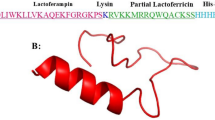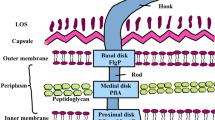Abstract
Ancylostoma ceylanicum is a common zoonotic nematode that inhabits the small intestine of humans, dogs, and cats. Saposin-like proteins (SLPs) have hemolytic and antibacterial activities and could be used as diagnostic or vaccine candidates. To explore the biological functions of Ancylostoma ceylanicum SLP (Ace-SLP-1), cDNA-encoding Ace-SLP-1 mature peptide was cloned into prokaryotic expression vector pET-28a and transformed into Escherichia coli BL21 (DE3) to induce expression. After incubation of canine red blood cell suspension with different concentrations of recombinant Ace-SLP-1, the supernatant was separated to measure OD value and calculate the hemolysis rate. The different concentrations of recombinant protein were co-cultured with E. coli and Enterococcus faecalis, and colony-forming units (CFU) were determined by the plate counting method. Peripheral blood mononuclear cells (PBMCs) from healthy dogs were incubated with different concentrations of recombinant Ace-SLP-1, and the cytokine expression was evaluated by relative quantitative PCR. Our results showed that the hemolytic activity of Ace-SLP-1 increased with the increase in protein concentration from 25 to 100 μg/mL. The recombinant protein had no antibacterial activity against the two kinds of bacteria but could stimulate the secretion of cytokines (IL-4, IL-10, IL-12, and IL-13) in canine PBMCs. These data suggest that Ace-SLP-1 is involved in hookworm blood-feeding and survival and has good immunogenicity, supporting its potential as a diagnostic and vaccine target molecule.




Similar content being viewed by others
References
Abuzeid AMI, Zhou X, Huang Y, Li GQ (2020) Twenty-five-year research progress in hookworm excretory/secretory products. Parasit Vectors 13(136):1–18
Andersson M, Gunne H, Agerberth B, Boman A, Bergman T, Sillard R, Jörnvall H, Mutt V, Olsson B, Wigzell H (1995) NK-lysin, a novel effector peptide of cytotoxic T and NK cells. Structure and cDNA cloning of the porcine form, induction by interleukin 2, antibacterial and antitumour activity. Embo J 14(8):1615–1625
Banz A, Peixoto A, Pontoux C, Cordier C, Rocha B (2003) A unique subpopulation of CD4+ regulatory T cells controls wasting disease, IL-10 secretion and T cell homeostasis. Eur J Immunol 33(9):2419–2428
Bartsch SM, Hotez PJ, Asti L, Zapf KM, Bottazzi ME, Diemert DJ, Lee BY (2016) The global economic and health burden of human hookworm infection. PLoS Negl Trop Dis 10(9):4922
Bruhn H (2005) A short guided tour through functional and structural features of saposin-like proteins. Biochem J 389(2):249–257
Chen J, Xu MJ, Zhou DH, Song HQ, Wang CR, Zhu XQ (2012) Canine and feline parasitic zoonoses in China. Parasit Vectors 5:152
Conlan JV, Khamlome B, Vongxay K, Elliot A, Pallant L, Sripa B, Blacksell SD, Fenwick S, Thompson RC (2012) Soil-transmitted helminthiasis in Laos: a community-wide cross-sectional study of humans and dogs in a mass drug administration environment. Am J Trop Med Hyg 86:624–634
Don TA, Jones MK, Smyth D, O’Donoghue P, Hotez P, Loukas A (2004) A pore-forming haemolysin from the hookworm, Ancylostoma caninum. Int J Parasitol 34:1029-1035
Don TA, Oksov Y, Lustigman S, Loukas A (2007) Saposin-like proteins from the intestine of the blood-feeding hookworm, Ancylostoma caninum. Parasitology 134(3):427-436
Espino AM, Hillyer GV (2003) Molecular cloning of a member of the Fasciola hepatica saposin-like protein family. J Parasitol 89(3):545–552
George S, Levecke B, Kattula D, Velusamy V, Kang G (2016) Molecular identification of hookworm isolates in humans, dogs and soil in a tribal area in Tamil Nadu. India Plos Negl Trop Dis 10(8):4891
Horowitz M, Zimran A (1994) Mutations causing Gaucher disease. Hum Mutat 3(1):1–11
Hotez PJ, Alvarado M, Basanez MG, Bolliger I, Naghavi M (2014) The global burden of disease study 2010: interpretation and implications for the neglected tropical diseases. PLoS Negl Trop Dis 8(7):2865
Hotez PJ, Beaumier CM, Gillespie PM, Strych U, Hayward T, Bottazzi ME (2016a) Advancing a vaccine to prevent hookworm disease and anemia. Vaccine 34(26):3001–3005
Hotez PJ, Strych U, Lustigman S, Bottazzi ME (2016b) Human anthelminthic vaccines: rationale and challenges. Vaccine 34(30):3549–3555
Inpankaew T, Schar F, Dalsgaard A, Khieu V, Chimnoi W, Chhoun C, Sok D, Marti H, Muth S, Odermatt P, Traub RJ (2014) High prevalence of Ancylostoma ceylanicum hookworm infections in humans Cambodia, 2012. Emerging Infect Dis 20(6):976–982
Kaya D, Yoshikawa M, Nakatani T, Tomo-Oka F, Fujimoto Y, Ishida K, Fujinaga Y, Aihara Y, Nagamatsu S, Matsuo E (2016) Ancylostoma ceylanicum hookworm infection in Japanese traveler who presented chronic diarrhea after return from Lao People’s Democratic Republic. Parasitol Int 65(6):737–740
Kishimoto Y, Hiraiwa M, O’Brien JS (1992) Saposins: structure, function, distribution, and molecular genetics. J Lipid Res 33(9):1255–1267
Kueakhai P, Meemon K, Changklungmoa N, Chaithirayanon K, Riengrojpitak S, Sobhon P (2011) Characterization and localization of saposin-like protein-2 (SAP-2) in Fasciola gigantica. Parasitol Res 108(6):1493–1500
Kurata K, Iwata A, Masuda K, Sakaguchi M, Ohno K, Tsujimoto H (2004) Identification of CpG oligodeoxynucleotide sequences that induce IFN-γ production in canine peripheral blood mononuclear cells. Vet Immunol Immunopathol 102(4):441–450
Lee JY, Cho PY, Kim TY, Kang SY, Song KY, Hong SJ (2002) Hemolytic activity and developmental expression of pore-forming peptide, clonorin. Biochem Biophys Res Commun 296(5):1238–1244
Leon L, Tatituri RV, Grenha R (2012) Saposins utilize two strategies for lipid transfer and CD1 antigen presentation. Proc Natl Acad Sci USA 109(12):4357–4364
Livak KJ, Schmittgen TD (2001) Analysis of relative gene expression data using real-time quantitative PCR and the 2 (-delta delta C (T)) method. Methods 25:402–408
Liu X (2015) The establishment and application of canine cell immune factors RT-qPCR. Doctoral dissertation, Northeast Agricultural University, China
Loukas A, Hotez PJ, Diemert D, Yazdanbakhsh M, Mccarthy JS, Correa-Oliveira R, Croese J, Bethony JM (2016) Hookworm Infection Nat Rev Dis Primers 2:16088
Munford RS, Sheppard PO, O’Hara PJ (1995) Saposin-like proteins (SAPLIP) carry out diverse functions on a common backbone structure. J Lipid Res 36(8):1653–1663
Ngui R, Lim YA, Traub R, Mahmud R, Mistam MS, Geiger SM (2012) Epidemiological and genetic data supporting the transmission of Ancylostoma ceylanicum among human and domestic animals. PLoS Negl Trop Dis 6(2):1522
Nuttall TJ, Knight PA, Mcaleese SM, Lamb JR, Hill PB (2002) T-helper 1, T-helper 2 and immunosuppressive cytokines in canine atopic dermatitis. Vet Immunol Immunopathol 87(3):379–384
Olmeda B, Garcia AB, Perez GJ (2013) Structure-function correlations of pulmonary surfactant protein SP-B and the saposin-like family of proteins. Eur Biophys J 42(2–3):209–222
Pena SV, Granulysin KAM (1997) a new human cytolytic granule-associated protein with possible involvement in cell-mediated cytotoxicity. Semin Immunol 9(2):117–125
Pujol M, Castillo F, Alvarez C, Rojas C, Borie C, Ferreira A, Vernal R (2017) Variability in the response of canine and human dendritic cells stimulated with Brucella canis. Vet Res 48(1):134–140
Ramakrishnan A, Althoff KN, Lopez JA, Coles CL, Bream JH (2012) Differential serum cytokine responses to inactivated and live attenuated seasonal influenza vaccines. Cytokine 60(3):661–666
Reed MB, Strugnell RA, Panaccio M, Spithill TW (2000) A novel member of the NK-lysin protein family is developmentally regulated and secreted by Fasciola hepatica. Mol Biochem Parasitol 105(2):297–303
Schmidli MR, Bettina F, Nadine K, David S, Michaela D, Ulrich R, Spreng DE, Simone F (2018) Inflammatory pattern of the infrapatellar fat pad in dogs with canine cruciate ligament disease. BMC Vet Res 14(1):45–53
Stehle ME, Hanczaruk M, Schwarz SCN (2010) Effects of polyunsaturated fatty acids on isolated canine peripheral blood mononuclear cells and cytokine expression (IL-4, IFN-γ, TGF-β) in healthy and atopic dogs. Vet Dermatol 21(1):113–118
Traub RJ (2013) Ancylostoma ceylanicum, a re-emerging but neglected parasitic zoonosis. Int J Parasitol 43(12–13):1009–1015
Traub RJ, Inpankaew T, Sutthikornchai C, Sukthana Y, Thompson RC (2008) PCR-based coprodiagnostic tools reveal dogs as reservoirs of zoonotic ancylostomiasis caused by Ancylostoma ceylanicum in temple communities in Bangkok. Vet Parasitol 155:67–73
WHO (2008) Soil-transmitted helminthiasis. Progress report on number of children treated with anthelminthic drugs: an update towards the 2010 global target. Weekly Epidemiol Rec 83(27/28):237–252
Wilkening G, Linke T, Sandhoff K (1998) Lysosomal degradation on vesicular membrane surfaces. Enhanced glucosylceramide degradation by lysosomal anionic lipids and activators. J Biol Chem 273(46):30271–30278
Williamson AL, Brindley PJ, Prociv AG, P, Loukas A, (2002) Cleavage of hemoglobin by hookworm cathepsin D aspartic proteases and its potential contribution to host specificity. FASEB J 16(11):1458–1460
Yang L, Johansson J, Ridsdale R, Willander H, Fitzen M, Akinbi HT, Weaver TE (2010) Surfactant protein B propeptide contains a saposin-like protein domain with antimicrobial activity at low pH. J Immunol 184(2):975–983
Zhang C (2010) Gene cloning, expression and related immunobiological characteristics of Schistosoma japonicum saposin-like protein. Master dissertation, Jiangsu Institute of Schistosomiasis Control, China
Funding
This work was supported by grants from the National Natural Science Foundation of China (Grant No. 31672541) and the Science and Technology Planning Project of Guangdong Province, China (Grant No. 2014A020214005).
Author information
Authors and Affiliations
Corresponding author
Ethics declarations
Ethical approval
Animal experiments involved in this study were performed in accordance with the guidelines of the Animal Welfare Law and Regulations of the Department of Health and Human Services, China, and were reviewed and approved by the South China Agricultural University Animal Care and Use Committee (approval number SYXK(Yue)2019–0136).
Conflict of interest
The authors declare no competing interests.
Additional information
Section Editor: Peter Fischer
Publisher's note
Springer Nature remains neutral with regard to jurisdictional claims in published maps and institutional affiliations.
Rights and permissions
About this article
Cite this article
He, L., Abuzeid, A.M.I., Zhuang, T. et al. Expression and biological functions of Ancylostoma ceylanicum saposin-like protein. Parasitol Res 120, 3805–3813 (2021). https://doi.org/10.1007/s00436-021-07313-6
Received:
Accepted:
Published:
Issue Date:
DOI: https://doi.org/10.1007/s00436-021-07313-6




